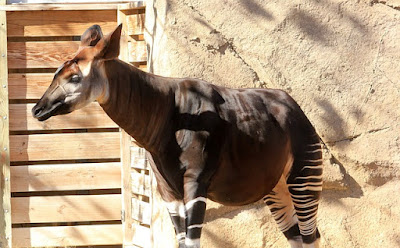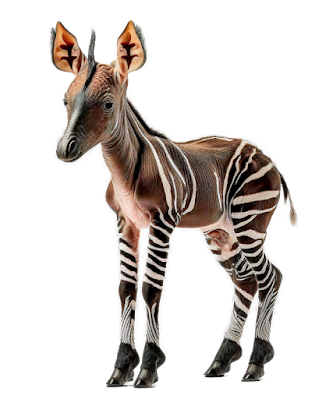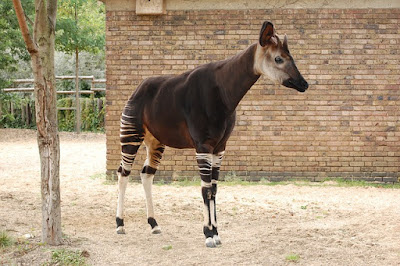Africa, a continent renowned for its diverse wildlife, is home to some of the most spectacular and mysterious creatures on the planet. One of these is the okapi (Okapia johnstoni), a remarkable and little-known species that inhabits the dense rainforests of Central Africa. Often known as the “forest giraffe” or the “African unicorn,” the okapi is truly a unique and fascinating animal that deserves our attention and conservation efforts.
A mysterious and elusive beauty
The okapi is an elusive creature, and its obscurity is further compounded by the fact that it was not scientifically described until the early 20th century. Its first known documentation by Western scientists occurred in 1901 when British explorer Sir Harry Johnston obtained some skin and skull samples from the native people of Congo. This newly found animal astonished the scientific community, as it appeared to be a strange mix of features from both a giraffe and a zebra, even though it was more closely related to the giraffe and zebra.
Physical characteristics
The okapi stands approximately 5.6 to 6.6 feet tall at the shoulder, similar in size to a horse. It has a velvety, brown coat with striking white horizontal stripes on its back, resembling a zebra. These stripes serve as a unique camouflage adaptation to its dense forest habitat, helping it blend seamlessly into low sunlight and the shade of bushes.
One of the okapi's most interesting features is its long, prehensile tongue, which can grow up to 18 inches long. This tongue allows it to capture leaves and buds from trees and bushes with remarkable precision. Their feeding habits primarily consist of plant matter, including leaves, fruits, and fungi, making them essential in seed dispersal within their ecosystem.
Habitat and behavior
The okapi's natural range is restricted to the dense rainforests of northeastern Democratic Republic of the Congo, where they lead solitary lives or live in small, dispersed family groups. Due to their elusive nature, seeing okapi in the wild is a rare and thrilling experience for researchers and tourists. They are known to be primarily crepuscular or nocturnal, making them even more difficult to encounter.
Their secretive lifestyle is also reflected in their vocalizations, which consist of soft vocal purrs and bellows, which allows them to communicate with each other without attracting the attention of potential predators or competitors.
Conservation status
Despite their mystique and intrigue, okapis face significant conservation challenges. Their habitat is increasingly threatened by logging, mining and agricultural activities, resulting in habitat fragmentation and degradation. Additionally, they are at risk of poaching due to the demand for their meat and their unique skin.
The Okapi Conservation Project (OCP), a collaboration between the Wildlife Conservation Society and the Congolese Institute for Nature Conservation, is working tirelessly to protect this species and its habitat. Their efforts include anti-poaching patrols, community education programs, and habitat conservation initiatives. Additionally, okapis are listed as Endangered on the International Union for Conservation of Nature (IUCN) Red List, making their protection even more urgent.
The okapi, a mysterious and captivating creature, serves as a symbol of the unknown biodiversity that still exists in our world. Its striking appearance, solitary nature and vital role in the ecosystem make it an invaluable part of Africa's rich wildlife heritage. As we become more aware of the okapi's plight, it is important that we work together to ensure its continued existence for future generations to admire and study. Conservation efforts, education and sustainable practices in the Congo Basin are essential to protect this living testament to the wonders of our planet's biodiversity.
Here are some interesting facts about okapis:
- Mysterious Relatives: Okapis are the giraffe's only living relatives. Although they share the same ancestor, the okapi's short neck and small size make them look quite different from their giant cousins.
- Elusive creatures: Okapis are known for their secretive and solitary behavior. They often go unnoticed in their dense rainforest habitat, making them challenging to study in the wild.
- Striped Appearance: Their most distinctive feature is the zebra-like stripes on their back and legs. It is believed that these stripes help them blend into the dappled sunlight and shade of the forest floor, thereby protecting them from predators.
- Tongue-Delicious: Okapis have an incredibly long, sensitive tongue that can reach up to 18 inches in length. This adaptation allows them to easily distinguish leaves, buds and other vegetation from trees and bushes.
- Forest dwellers: These creatures are native to the dense rainforests of northeastern Democratic Republic of the Congo in Central Africa. They have evolved to thrive in this unique and challenging environment.
- Nocturnal Lifestyle: Okapis are primarily crepuscular and nocturnal, meaning they are most active during dawn and dusk. This behavior helps them avoid daytime predators and remain hidden from human observers.
- Solitary or small groups: Okapis typically lead solitary lives or live in small, dispersed family groups. They are not known for forming large herds like some other herbivorous animals.
- Communication: Okapi communicate through soft vocalizations such as purrs and bellows, which allows them to communicate with other okapi in the wild without attracting unwanted attention.
- Conservation Status: Okapis are listed as Endangered on the IUCN Red List of Threatened Species. Their population is declining due to habitat loss due to logging, mining and agriculture, as well as poaching for their meat and skin.
- Conservation Efforts: Many organizations, including the Okapi Conservation Project (OCP), are dedicated to protecting these unique creatures and their habitat. Anti-poaching patrols, community education programs, and habitat conservation initiatives are important components of these conservation efforts.
- Symbol of Conservation: The Okapi serves as a symbol of the importance of conserving the biodiversity of the Congo Basin rainforests, which are vital not only for okapis but also for many other endangered species and the overall health of the planet.
- Ancient existence: Okapis are considered a living fossil, as they have existed for millions of years with little change in their physical characteristics, making them a fascinating glimpse into Earth's wildlife past.



Comments
Post a Comment